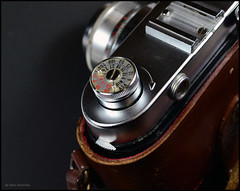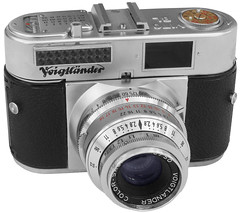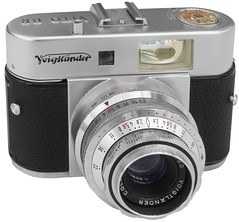Vito B
| ||
|
The Voigtländer Vito B is an attractive and compact 35mm viewfinder introduced in 1954 by Voigtländer, and produced until 1959. The Vito B continued the Vito name in a rigid body, instead of folders. The Vito B's body is compact and rounded, similar to the Vito IIa, a look characterized as "cute"[1] but feels solid in the hand and is very stable.
The Vito B has some nice features including a hinged baseplate for easy loading (which also releases the back), a milled film counter that counts down rather than up, and a switch-operated pop-up rewind knob. There is a small foot under the front plate to stabilize the camera for use on table-tops. The Voigtlander name is engraved and painted black int he front, while VITO B is embossed on top and chromed.
The first versions (1954 to 1957) had a small viewfinder and low profile top plate, while the later version (1957 to 1959) had a larger bright-frame viewfinder. While the later models had a brighter (and more useful than the original Vito B's) viewfinder, some enthusiasts feel that this spoiled the appearance of the camera.[2]
Lenses
All versions of the Vito B were fitted with the Color-Skopar 50mm fixed lens, with either an f/3.5 or f/2.8 maximum aperture (a four element Tessar-type) with focusing by rotating the front element.
Shutter
Many Vito Bs were equipped with a 4-speed Pronto (B, 1/25th, 1/50th, 1/100th, and 1/200th sec., or B, 1/30th, 1/60th, 1/125th, 1/250th sec.), or 8-speed (B, 1, 1/2, 1/5th, 1/10th, 1/25th, 1/50th, 1/100th, and 1/300th sec.).
Later models switched to modern speeds Prontor SVS shutters with 4 or 9 speeds (B, 1, 1/2, 1/4th, 1/8th, 1/15th, 1/30th, 1/60th, 1/125th, 1/300th sec.), plus one (rare) model with a 10 speed Prontor SVS shutter that had the option of 1/500th.
|
The last Vito Bs (both small and large viewfinder variants) also had the facility to set an Exposure Value, which synchronized shutter and aperture settings.
The shutter is cocked by the film engaging a sprocket wheel, preventing double exposure, and so will not cock if there is not a film present;[3] this has led some to mistakenly diagnose the shutter of a working Vito B as broken.
The self-timer mechanism can be engaged by moving the synchronizing lever to the V (green) position; however, given the age of the camera and the weak governing spring,[4] using this feature is discouraged, as it can cause the camera to stop working.[3]
Nine times out of ten, a non working self timer is due to muck, not springs. There is a watch mechanism that controls the self timer, but, unlike a watch, it is not effectively sealed. Nearly all cameras with Prontor or Compur mechanisms need regular cleaning even if they are used regularly. Even the shutter timing mechanism is clockwork and it only takes a speck of dust to jam it. People then start ripping them apart, usually from the wrong end and end up with a pile of non working bits. (Guess how I know). (Added by Laurie Pettitt)
Specifications
- Country of origin: Germany
- Manufacturer: Voigtländer
- In production: 1954-1960
- Film: 135 (perforated 35mm) for 24x36mm images
- Lens: Color Skopar 50 f/3.5 or 50mm f/2.8
- Viewfinder: Optical-viewfinder with framelines
- Shutters observed:
- Dimensions: 118 × 75 × 70mm ; weight 605g
Variants
There are several variations of the Vito B, based upon different types of shutter, two different lenses (f/2.8 or f/3.5 50mm Color Skopar), with and without an EV setting lens scale, and small and large viewfinders.
The Vito B family also included cameras that shared the same base chassis but had extended functions such as:
| ||
|
a) The Vito BL (1958) features an uncoupled selenium exposure meter made by Ernst & Wilhelm Bertram. Two variations exist, depending on the lightmeter (Bewi or Bertram)
- Bertram meter is a needle meter that has no sensitivity adjustment according to film speed. The meter needle deflects to indicate an EV zones along it's length, so the correct reading is made at the red tip of the pointer. EV zones are alternating black and white bands, where black zones have numbers and white zones do not. Instead the EV scale is changed via a small knob on the back of the camera top-plate, which rotates a drum. Each EV scale on the drum is assigned a letter ID, and an engraved table on the top-plate must be used to lookup the letter setting for the film speed. This table covers speeds from 6 to 200 ASA (but once again, there may have been range variations?). The table also includes DIN and WES film speeds (Weston Film Speed ratings - found on Weston exposure meters, and were sometimes referred to by film manufactures as third party speeds). The EV reading is then manually transferred to the lens settings. The Bertram meter was fitted to later cameras.
- Bewi-Automat meter has no pointer needle but readings based on Exposure Value (EV). There is a dial on the top-plate with an ASA or DIN film speed ring. A button on the back of the camera top-plate activated the meter, and had to be pressed for at least one second before releasing slowly. This caused aperture and shutter speed dials to rotate and align on the meter dial, and show appropriate exposure combinations (EV). The camera has a Prontor SVS shutter with EV Scale, and the meter readings are transferred to the equivalent shutter speed+Aperture settings. Bewi-Automat meter covers a range of EV between 2 and 17 (4 to 16 for ASA 100)
b) The Vito BR has a coupled rangefinder and is quite uncommon. The rangefinder base was short, and only a few were made (~11.000) [5][6]
Notes
- ↑ Elek 2008.
- ↑ Keith South, Voigtlander Vito B, skopar f/2.8, 35mm camera c1954.
- ↑ 3.0 3.1 South 2001.
- ↑ Denton, Voigtlander Vito B
- ↑ Vito BR protoype at the Voigtlander-archiv
- ↑ Vito BR at CJ's classic cameras
Links
In English:
- Voigtländer Vito B user manual (pdf) at Butkus.org
- Matt Denton, Voigtlander Vito B.
- Daniel Jiménez, Voigtländer Vito B (archived)
- Mike Elek (2008), Voigtlander Vito B.
- Keith South (2001), Voigtlander Vito B survey. Living Image Camera Museum.
- Keith South, Voigtlander Vito B, 35mm camera c1954.
- Voigtländer Vito BL review at 35mmc.com
In German:
- Hans Lißberger, Vito B at Meine Voigtländer-Sammlung (archived).
In French:
- Vito B, Vito BL, Vito B user manual: German and French on www.collection-appareils.fr by Sylvain Halgand




